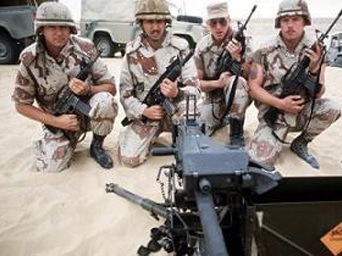
by Brian Washington, VA Intern

One of the main concerns to the West was the significant threat Iraq posed to Saudi Arabia. Following the take-over of Kuwait, the Iraqi army was within easy striking distance of Saudi oil fields. Control of these fields, along with Kuwaiti and Iraqi reserves, would have given Saddam Hussein control over the majority of the world’s oil reserves. Iraq also had a number of reasons to not get along with Saudi Arabia. The Saudis had lent Iraq some 26 billion dollars during its war with Iran. The Saudis supported Iraq, as they feared the power of Shia, Iran’s Islamic revolution on its own Shia minority. After the war, Saddam felt he should not have to repay the loans due to the help he had given the Saudis by fighting Iran.
Acting on the policy of the Carter Doctrine, and out of fear the Iraqi army would launch an attack on Saudi Arabia; U.S. President George H. W. Bush quickly announced that the U.S. would launch a “wholly defensive” mission to prevent Iraq from invading Saudi Arabia under the nickname Operation Desert Shield. Operation Desert Shield began August 7, 1990 when U.S. troops were sent to Saudi Arabia. Their deployment was also influenced by the request of Saudi ruler, King Fahd, who had earlier called for U.S. military assistance. On August 8th, the “wholly defensive” doctrine was quickly abandoned when Iraq declared Kuwait to be its 19th province and Saddam Hussein named his cousin, Ali Hassan Al-Majid, as its military-governor.
The United States Navy sent off two naval battle groups built around the aircraft carriers USS Dwight D. Eisenhower and USS Independence to the Gulf, where they were ready by August 8th. The U.S. also sent the battleships USS Missouri and USS Wisconsin to the region. A total of 48 U.S. Air Force F-15s from the 1st Fighter Wing at Langley Air Force Base, Virginia landed in Saudi Arabia, and immediately, began round-the-clock air patrols of the Saudi–Kuwait–Iraq borders to hold off further Iraqi military advances.
Military buildup continued from there, eventually reaching 543,000 troops; twice the number used in the 2003 attack of Iraq. Much of the material was airlifted or carried to the staging areas by fast sealift ships, allowing a quick buildup.
On January 17, 1991, it became clear that Saddam would not withdraw, and Desert Shield became Desert Storm.
ATTENTION READERS
We See The World From All Sides and Want YOU To Be Fully InformedIn fact, intentional disinformation is a disgraceful scourge in media today. So to assuage any possible errant incorrect information posted herein, we strongly encourage you to seek corroboration from other non-VT sources before forming an educated opinion.
About VT - Policies & Disclosures - Comment Policy



